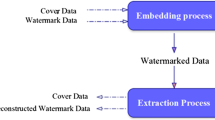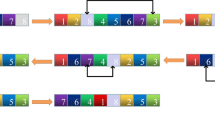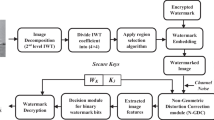Abstract
Medical image watermarking has received increasing attention as wide security services in the e-diagnosis system, where the images are transmitted through the internet among the patient, primary physicians, and referred physicians. These images are highly prone to become corrupted and erroneous due to the inherent noise in the wireless medium. Such error results in serious adverse impacts including inconsistent and unreliable transmission, faulty watermark detection, and faulty diagnosis. To solve the problem, we propose a (8, 4) Hamming code based error correction. In addition, we implement the Hamming code on a graphics processing unit (GPU) to accelerate and meet the real-time requirement. The experimental results demonstrate that the GPU based approach exceedingly outperforms the CPU based error correction in terms of execution time.












Similar content being viewed by others
References
Memon, N.A., Gilani, N.A., Qayoom, S.: Multiple watermarking of medical images for content authentication and recovery. In: Proceedings of the IEEE 13th International Multitopic Conference, pp. 1–6, 14–15 Dec. 2009.
Huang, K.-C., Huang, T.-C., Tsai, M.-J., Chang, H.-Y., Tung, Y.-H.: Moldable job scheduling for HPC as a service with application speedup model and execution time information. J. Convergence 4(4), 14–22 (Dec. 2013)
Al-Gindy, A.: A fragile invertible watermarking technique for the authentication of medical images. In: Proceedings of the IEEE International Symposium on Signal Processing and Information Technology, pp. 191–195, 15–18 Dec. 2010
Luo, X., Cheng, Q., Tan, J.: A lossless data embedding scheme for medical images in application of e-diagnosis. In: Proceedings of the 25th IEEE Annual International Conference of the Engineering in Medicine and Biology Society, vol. 1, pp. 852–855, 17–21 Sept. 2003
Lisowiec, A., Nowakowski, A., Ksiazek, L.: Signal processing in switchgear e-diagnosis network. In: Proceedings of the International Symposium on Power Electronics, Electrical Drives, Automation and Motion, pp. 993–996, 20–22 June 2012.
Hsieh, S.J.: Work in progress—integrating technology for e-diagnosis of automated manufacturing system. In: Proceedings of the Annual Frontiers in Education, vol. 1, pp. 12–13, 20–23 Oct. 2004.
Gnanaraj, J., Ezra, K., Rajsingh, E.: Smart card based time efficient authentication scheme for global grid computing. J. Human-Centric Comput. Info. Sci. 3(16), 1–17 (Sep. 2013)
Walia, R., Aendenroomer, A., Mok, G.K.: An intelligent immune agent management system for facilitating e-diagnosis in manufacturing. In: Proceedings of the IEEE International Conference on Industrial Informatics, pp. 791–796, 10–12 Aug. 2005.
Iftikhar, M., Singh, H.M.P., Arifianto, M.S.: Telecardiology for e-diagnosis and e-learning in rural area of sabah, Malaysia: a novel approach for cardiac services in rural medicine. In: Proceedings of the International Conference on Advances in Human-Oriented and Personalized Mechanisms, Technologies and Services, pp. 83–88, 22–27 Aug. 2010.
Coatrieux, G., Huang, H., Shu, H., Luo, L., Roux, C.: A watermarking-based medical image integrity control system and an image moment signature for tampering characterization. IEEE J. Biomed. Health Info. 17(6), 1057–1067 (Nov. 2013)
Chong, J., Ng, C., Noordin, N., Ali, B.: Dynamic transmit antenna shuffling scheme for MIMO wireless communication systems. J. Convergence 4(1), 7–14 (Mar. 2013)
Luo, Y., Hoeber, O., Chen, Y.: Enhancing Wi-Fi fingerprinting for indoor positioning using human-centric collaborative feedback. J. Human-centric Comput. Info. Sci. 3(2), 1–23 (Mar. 2013)
Algur, S., Kumar, N.: Novel user centric, game theory based bandwidth allocation mechanism in WiMAX. J. Human-centric Comput. Info. Sci. 3(20), 1–20 (Nov. 2013)
Chung, W., Kumar, S., Paluri, S., Nagaraj, S., Annamalai, A., Matyjas, J.D.: A cross-layer unequal error protection scheme for prioritized H.264 video using RCPC codes and hierarchical QAM. J. Info. Process. Sys. 9(1), 53–68 (2013)
Sharma, B., Bhatia, R.S., Singh, A.K.: A token based protocol for mutual exclusion in mobile Ad hoc networks. J. Info. Process. Sys. 10(1), 36–54 (2014)
Gohar, M., Koh, S.-J.: A network-based handover scheme in HIP-based mobile networks. J. Info. Process. Sys. 9(4), 651–659 (2013)
Pushpala, K., Nigudkar, K.: A novel watermarking technique for medical image authentication. In: Proceedings of the IEEE symposium on Computers in Cardiology, pp. 683–686, Sept. 2005.
Agung, B.W.R., Permana, F.P.A.: Medical image watermarking with tamper detection and recovery using reversible watermarking with LSB modification and run length encoding (RLE) compression. In: Proceedinds of the 2012 IEEE International Conference on Communication, Networks and Satellite (ComNetSat), pp. 167–171, July 2012.
Adiwijaya, K., Faoziyah, P.N., Permana, F.P., Wirayuda, T.A.B., Wisesty, U.N.: Tamper detection and recovery of medical image watermarking using modified LSB and Huffman compression. In: Proceedings of the 2013 Second International Conference on Informatics and Applications, pp. 129–132, Sept. 2013.
Li, J., Liu, Y., Du, W., Chen, Y.W.: The medical image watermarking algorithm based on DFT and logistic map. In: Procedings of the 2012 7th International Conference on Computing and Convergence Technology, pp. 1–6, 3–5 Dec. 2012.
Coatrieux, G., Huang, H., Shu, H., Luo, L., Roux, C.: A watermarking-based medical image integrity control system and an image moment signature for tampering characterization. IEEE J. Biomed. Health Info. 17(6), 1057–1067 (2013)
Alamgir, N., Kim, J.-M.: Fuzzy clustering based medical image watermarking. KIPS Trans. Softw. Data Eng. 2(2), 487–494 (July 2013)
Kim, T.-J., Kim, B.-G., Park, C.-S., Jang, K.-S.: Efficient block mode determination algorithm using adaptive search direction information for scalable video coding (SVC). J. Convergence 5(1), 14–19 (Mar. 2014)
Alamgir, N., Kang, M.Y., Kwon, K., Kim, C.-H., Kim, J.: A Hybrid Technique for Medical Image Segmentation. J. Biomed. Biotechnol. 2012, 1–7 (2013)
Li, R., Dou, Y., Li, Y., Wang, S.: A fully parallel truncated Viterbi decoder for software defined radio on GPUs. In: Proceedings of the 2013 IEEE Wireless Communications and Networking Conference (WCNC), pp. 4305–4310 2013.
Palkovic, M., Raghavan, P., Li, M., Dejonghe, A., Van der Perre, L., Catthoor, F.: Future software-defined radio platforms and mapping flows. IEEE Mag. Signal Process. 27(2), 22–33 (2010)
Wu, M., Sun, Y., Gupta, S., Cavallaro, J.R.: Implementation of a high throughput soft MIMO detector on GPU. J. Signal Process. Sys. 64(1), 123–136 (2011)
Lin, C.S., Liu, W.L., Yeh, W.T., Chang, L.W., Hwu, W.M.W., Chen, S.J., Hsiung, P.A.: A tiling-scheme viterbi decoder in software defined radio for GPUs. In: Proceedings of the 7th International Conference on Wireless Communications, Networking and Mobile Computing (WiCOM), pp. 1–4, 2011
NVIDIA Corporation, NVIDIA CUDA Compute Unified Device Architecture Programming Guide version 4.0 (2011)
Sanders, J., Kandrot, E.: CUDA by Example: An Introduction to General-Purpose GPU Programming, 1st edition (2010)
Kirk, D.B., Hwu, W.W.: Programming Massively Parallel Processors: A Hands-on Approach, 2nd edition (2012)
Hamming, R.W.: Error detecting and error correcting codes. Bell Sys. Techn. J. 26(2), 147–160 (1950)
Ma, R., Cheng, S.: The universality of generalized hamming code for multiple sources. IEEE Trans. Commun. 59(10), 2641–2647 (Oct. 2011)
Acknowledgments
This work was supported by a National Research Foundation of Korea (NRF) Grant funded by the Korean government (MEST) (No. NRF-2013R1A2A2A05004566).
Author information
Authors and Affiliations
Corresponding author
Rights and permissions
About this article
Cite this article
Islam, M.S., Kim, CH. & Kim, JM. A GPU-based (8, 4) Hamming decoder for secure transmission of watermarked medical images. Cluster Comput 18, 333–341 (2015). https://doi.org/10.1007/s10586-014-0392-x
Received:
Revised:
Accepted:
Published:
Issue Date:
DOI: https://doi.org/10.1007/s10586-014-0392-x




